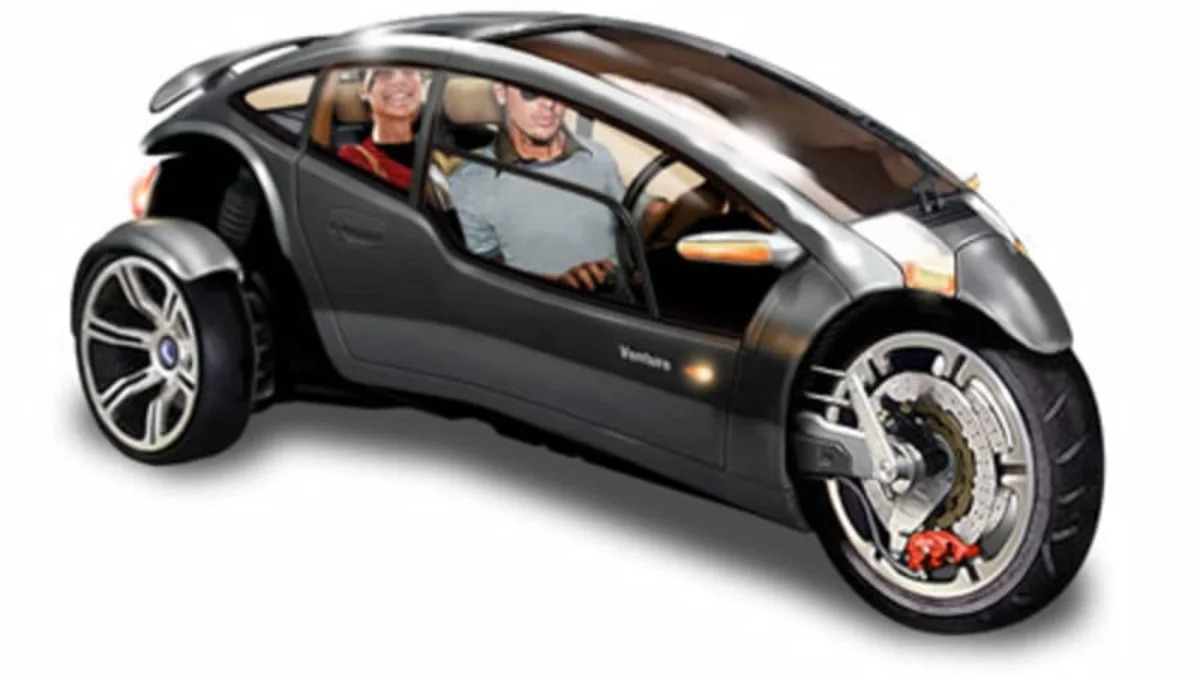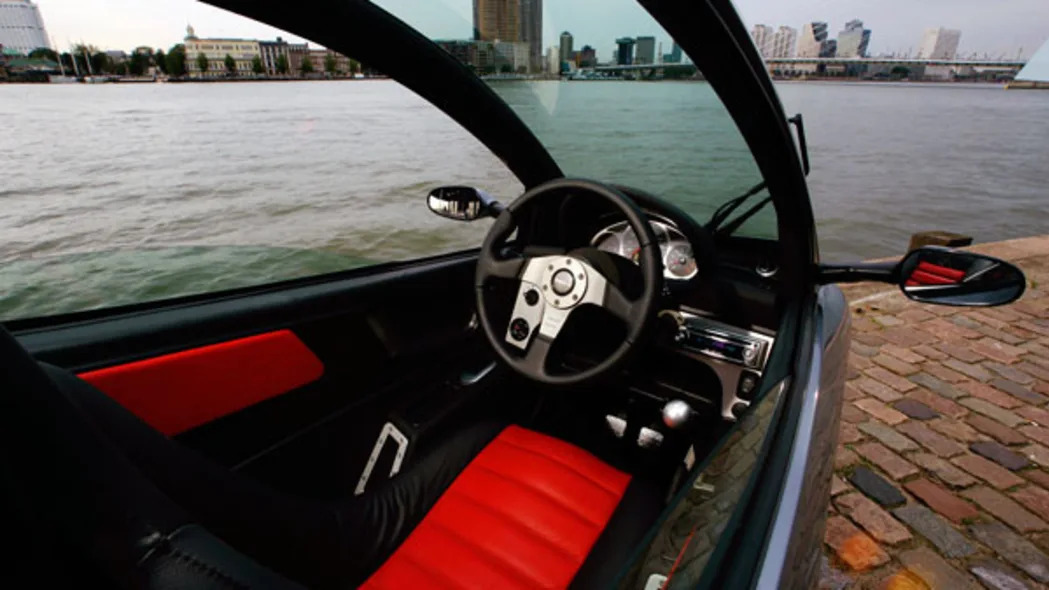Click on the image for a gallery of 29 images of the VentureOne concept and the Carver three-wheeler.
It is my pleasure to bring you a comprehensive interview with Ian Bruce, founder of Venture Vehicles and their EVP Design & Engineering. Venture Vehicles are creating the VentureOne, a new, greener version of the Carver three-wheeler to be designed and built in California. The Carver pioneered an innovative take on personal transport, combining aspects of both motorcycles and cars to create a fun and efficient way to cruise around. The VentureOne will build upon this platform with updates for safety, performance, improved fuel efficiency and reduced emissions.
If you haven't already, be sure to read our guide to the VentureOne first as background to this insightful interview. Ian, who originally sent us details on the VentureOne himself, was incredibly generous with his time in answering my questions with the final interview being too long to post in one go. As such, I have split the interview in half and it will be run over two days.
Today, we cover Ian's personal background and involvement with Venture Vehicles, plus the design of the VentureOne concept.
ABG: What is your role with Venture Vehicles? Tell us a bit more about your background in the auto industry.
IB: I'm the founder of Venture Vehicles, along with my partner Howard Levine, but my official title is EVP of Design & Engineering. While I'm not coming from an automotive background, I've been an avid motorcycle enthusiast and general gear-head all my life. I don't think that's a detriment -- what was needed was the ability to recognize an opportunity, and the will to carry it out. Frankly, I couldn't see Ford or GM pursuing something like this much beyond the concept stage.
Volkswagen did with the GX3, but killed the project due to liability concerns. You're probably aware that VW's "Moonraker" team created the vehicle's styling -- but the actual chassis, or "mule", was designed, engineered, and built by Swift Engineering in Southern California.
The lead engineer on that project was Chris Norris, who is now doing the chassis, suspension and propulsion engineering for the VentureOne. We're fortunate to have him as he probably has more experience with 3-wheelers than anyone else in the country. (BTW: he was the one videotaping the back of my head).
Interview continues after the jump.
ABG: When was the original Carver released and what type of powertrain did it have?
IB: The original Carver was developed over 10 years, and certified for road use in EU in 2005. It uses a turbocharged 660cc Daihatsu K-car engine which develops about 65 bhp (~50kW). Reliable, but otherwise unremarkable.
I decided early on that in-wheel motors were a better way to go. Having two computer-controlled rear motors allow us to implement regenerative braking, traction control, steering control, and inertially adaptive ABS breaking functions entirely as software. There is no additional hardware at all -- i.e.: upgradable, and no parts to buy -- or worse, fail or wear out. The front brakes are caliper type, identical to motorcycles. The rear brakes however are entirely electronic, and completely self-powered. In other words, they function at 100% breaking capacity -- even in the event of a complete electrical systems failure.
ABG: Using software to program computer-controlled electric motors provides the VentureOne with huge benefits over traditional mechanical systems - did you develop your regenerative braking, traction control, steering control system software in-house?
IB: Getting rid of the transmission has a major benefit... to say the least. Imagine two motors with one moving part each -- and that includes the wheel! Besides enhancing reliability, it makes our vehicle lighter, more functional, and less expensive to manufacture.
The software development specific to propulsion is being done by California Motors and Swift Engineering, and will be proprietary. Losing all the hardware also allows us to upgrade VentureOne owner's vehicles quickly and easily as the software improves or new features are added.
 ABG: I really like the VentureOne concept rendering that appears on your website. Did you create that?
ABG: I really like the VentureOne concept rendering that appears on your website. Did you create that?
IB: Thanks for the compliment on the illustration. It's only a design direction for BMW DesignWorks -- what they create will be significantly different than anything I can put together in PhotoShop. My background is in design and visual communications, though I hold patents in things as diverse as emergency equipment and micro-optical display systems.
ABG: The original Carver pioneered the use of an articulated system where the front of the vehicle was able to tilt based on your speed and aggressiveness of turn while the rear two wheels remained firmly on the ground. Have you had to deviate from this basic design at all in designing the VentureOne?
IB: Not at all. We've licensed this technology for a very good reasons: it works... and very well by the way. Carver Engineering has spent 10 years perfecting this system and we're extremely impressed with the result.
ABG: Did you have to team up with a specialist group to develop your hybrid system?
IB: Brian Huff, the Chief Engineer at California Motors is lead on hybrid system design. We've had California Motors create a preliminary Power Requirements Model (PRM), which, as the name suggests, estimates the torque and power requirements needed for the vehicle to perform as specified -- as well as addressing common driving variables like climbing slopes at different speeds, and traversing obstacles like speed bumps, and curbs.
Some of the other targets and dynamic variables we're playing with are mileage targets, vehicle weight, aerodynamic drag coefficients, rolling resistance, and other loading factors. Naturally, a big one is the energy issue -- that is, what are the minimum kW/h's we can safely get away with, without compromising the vehicle's mission envelope. As with any BEV or HEV, battery configuration has the biggest impact on the cost/performance equation.
We're working with Dr. Any Chu at A123 Systems, a spin-off of MIT, who are designing and integrating our battery modules. Their cells have twice the power-density of typical Li-Ion packs, are entirely earth-friendly, and can achieve a 90% charge-state in as little as 15 minutes. They're expensive, but our storage demands are considerable smaller than that of something like the Tesla Roadster -- who's battery pack is roughly 20 times the size of ours.
ABG: Tesla Motors advertise that their li-Ion batteries are good for 500 complete charge/discharge cycles giving their Roadster a conservative battery life-span of 100,000 miles. What do you estimate the battery pack life-span of the VentureOne to be?
IB: 500? I'll admit that I didn't know that. I wonder if that figure takes impedance growth into account.
The two primary issues with battery calendar life are Cycle LIfe and impedance growth -- that is, the increase of internal resistance over time. We're working with A123 Systems on the VentureOne's battery system, and are assured that we can expect several thousands of cycles to a 100% depth of discharge. A123's cells also have a feature that lowers their internal resistance over their life-time to compensate for increasing impedance. It's really quite clever. The battery's operational temperature range is equally impressive: -22 to 158°F (-30° to 70°C).
The batteries produced by A123 are also chemically benign, and do not support either combustion or thermal-runaway. As an Earth-friendly and people-friendly company, that's just the way we like things.
Something else to consider is that the battery in the Tesla is 20 times the size of our hybrid. 45lbs vs. 900lbs. That's nearly the weight of our entire vehicle.
It is my pleasure to bring you a comprehensive interview with Ian Bruce, founder of Venture Vehicles and their EVP Design & Engineering. Venture Vehicles are creating the VentureOne, a new, greener version of the Carver three-wheeler to be designed and built in California. The Carver pioneered an innovative take on personal transport, combining aspects of both motorcycles and cars to create a fun and efficient way to cruise around. The VentureOne will build upon this platform with updates for safety, performance, improved fuel efficiency and reduced emissions.
If you haven't already, be sure to read our guide to the VentureOne first as background to this insightful interview. Ian, who originally sent us details on the VentureOne himself, was incredibly generous with his time in answering my questions with the final interview being too long to post in one go. As such, I have split the interview in half and it will be run over two days.
Today, we cover Ian's personal background and involvement with Venture Vehicles, plus the design of the VentureOne concept.
ABG: What is your role with Venture Vehicles? Tell us a bit more about your background in the auto industry.
IB: I'm the founder of Venture Vehicles, along with my partner Howard Levine, but my official title is EVP of Design & Engineering. While I'm not coming from an automotive background, I've been an avid motorcycle enthusiast and general gear-head all my life. I don't think that's a detriment -- what was needed was the ability to recognize an opportunity, and the will to carry it out. Frankly, I couldn't see Ford or GM pursuing something like this much beyond the concept stage.
Volkswagen did with the GX3, but killed the project due to liability concerns. You're probably aware that VW's "Moonraker" team created the vehicle's styling -- but the actual chassis, or "mule", was designed, engineered, and built by Swift Engineering in Southern California.
The lead engineer on that project was Chris Norris, who is now doing the chassis, suspension and propulsion engineering for the VentureOne. We're fortunate to have him as he probably has more experience with 3-wheelers than anyone else in the country. (BTW: he was the one videotaping the back of my head).
Interview continues after the jump.
ABG: When was the original Carver released and what type of powertrain did it have?
IB: The original Carver was developed over 10 years, and certified for road use in EU in 2005. It uses a turbocharged 660cc Daihatsu K-car engine which develops about 65 bhp (~50kW). Reliable, but otherwise unremarkable.
I decided early on that in-wheel motors were a better way to go. Having two computer-controlled rear motors allow us to implement regenerative braking, traction control, steering control, and inertially adaptive ABS breaking functions entirely as software. There is no additional hardware at all -- i.e.: upgradable, and no parts to buy -- or worse, fail or wear out. The front brakes are caliper type, identical to motorcycles. The rear brakes however are entirely electronic, and completely self-powered. In other words, they function at 100% breaking capacity -- even in the event of a complete electrical systems failure.
ABG: Using software to program computer-controlled electric motors provides the VentureOne with huge benefits over traditional mechanical systems - did you develop your regenerative braking, traction control, steering control system software in-house?
IB: Getting rid of the transmission has a major benefit... to say the least. Imagine two motors with one moving part each -- and that includes the wheel! Besides enhancing reliability, it makes our vehicle lighter, more functional, and less expensive to manufacture.
The software development specific to propulsion is being done by California Motors and Swift Engineering, and will be proprietary. Losing all the hardware also allows us to upgrade VentureOne owner's vehicles quickly and easily as the software improves or new features are added.
 ABG: I really like the VentureOne concept rendering that appears on your website. Did you create that?
ABG: I really like the VentureOne concept rendering that appears on your website. Did you create that?
IB: Thanks for the compliment on the illustration. It's only a design direction for BMW DesignWorks -- what they create will be significantly different than anything I can put together in PhotoShop. My background is in design and visual communications, though I hold patents in things as diverse as emergency equipment and micro-optical display systems.
ABG: The original Carver pioneered the use of an articulated system where the front of the vehicle was able to tilt based on your speed and aggressiveness of turn while the rear two wheels remained firmly on the ground. Have you had to deviate from this basic design at all in designing the VentureOne?
IB: Not at all. We've licensed this technology for a very good reasons: it works... and very well by the way. Carver Engineering has spent 10 years perfecting this system and we're extremely impressed with the result.
ABG: Did you have to team up with a specialist group to develop your hybrid system?
IB: Brian Huff, the Chief Engineer at California Motors is lead on hybrid system design. We've had California Motors create a preliminary Power Requirements Model (PRM), which, as the name suggests, estimates the torque and power requirements needed for the vehicle to perform as specified -- as well as addressing common driving variables like climbing slopes at different speeds, and traversing obstacles like speed bumps, and curbs.
Some of the other targets and dynamic variables we're playing with are mileage targets, vehicle weight, aerodynamic drag coefficients, rolling resistance, and other loading factors. Naturally, a big one is the energy issue -- that is, what are the minimum kW/h's we can safely get away with, without compromising the vehicle's mission envelope. As with any BEV or HEV, battery configuration has the biggest impact on the cost/performance equation.
We're working with Dr. Any Chu at A123 Systems, a spin-off of MIT, who are designing and integrating our battery modules. Their cells have twice the power-density of typical Li-Ion packs, are entirely earth-friendly, and can achieve a 90% charge-state in as little as 15 minutes. They're expensive, but our storage demands are considerable smaller than that of something like the Tesla Roadster -- who's battery pack is roughly 20 times the size of ours.
ABG: Tesla Motors advertise that their li-Ion batteries are good for 500 complete charge/discharge cycles giving their Roadster a conservative battery life-span of 100,000 miles. What do you estimate the battery pack life-span of the VentureOne to be?
IB: 500? I'll admit that I didn't know that. I wonder if that figure takes impedance growth into account.
The two primary issues with battery calendar life are Cycle LIfe and impedance growth -- that is, the increase of internal resistance over time. We're working with A123 Systems on the VentureOne's battery system, and are assured that we can expect several thousands of cycles to a 100% depth of discharge. A123's cells also have a feature that lowers their internal resistance over their life-time to compensate for increasing impedance. It's really quite clever. The battery's operational temperature range is equally impressive: -22 to 158°F (-30° to 70°C).
The batteries produced by A123 are also chemically benign, and do not support either combustion or thermal-runaway. As an Earth-friendly and people-friendly company, that's just the way we like things.
Something else to consider is that the battery in the Tesla is 20 times the size of our hybrid. 45lbs vs. 900lbs. That's nearly the weight of our entire vehicle.
Stay tuned tomorrow (now available) for the second installment of the interview where I ask Ian about the safety of the VentureOne and his plans to bring it to market.



Sign in to post
Please sign in to leave a comment.
Continue